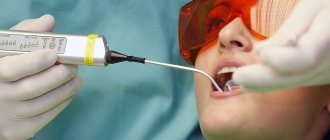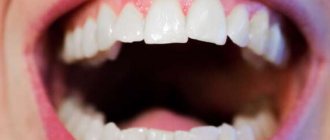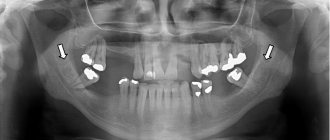My cheek is swollen after dental treatment - what to do?
- Dentistry Kyiv | Dental clinic in Kyiv. Solomenka.
- >
- Articles
- >
- My cheek is swollen after dental treatment - what to do?
Sometimes after tooth treatment (especially after removal and root canal treatment), an alarming picture is observed - a swollen cheek. Moreover, such a picture can be observed even after visiting a highly qualified specialist who did not make a single mistake during the therapeutic procedures. What causes this complication, and how to act when it occurs?
Reasons why the cheek swells after tooth extraction
After tooth extraction, an inflammatory process occurs in the soft tissues of the oral cavity - this is the main cause of edema and swelling. If the operation is performed correctly and the patient has followed all the dentist’s recommendations, the non-infectious inflammation will go away on its own, without antibiotics or complications, and along with it, pain and swelling will go away.
The duration of swelling varies depending on the surgical technique, which tooth was removed, the condition of the oral cavity, and finally, the physical condition of the patient and his immune system. On average, swelling lasts 3-4 days, but can last for 7 days. If after a week the swelling has not subsided, this is a sign of the development of complications and a reason to consult a specialist.
Swelling appears a few hours after surgery (after the anesthesia wears off). At the same time, the patient may feel aching pain, and ichor is released from the wound. A slight increase in temperature is allowed. All these symptoms are considered natural and do not pose any danger. And to relieve pain, you can take painkillers analgesics.
Maximum swelling is recorded on days 3-4, from this moment it begins to decrease and by the seventh day it completely disappears. But the cheek can swell immediately after depulpation; this happens if the patient had gumboil and the tumor developed even before the operation.
How to relieve cheek swelling after dental treatment?
In order to relieve pain in the tooth, gum and cheek after treatment, as well as relieve swelling, DD Clinic specialists recommend their patients to do simple procedures at home.
- Rinsing the mouth with an antiseptic, which will be prescribed by the attending doctor depending on the cause of the swelling;
- In case of an allergic reaction, take antihistamines, such as tavegil, suprastin, Erius, etc.;
- In case of infectious inflammation of the cheek, take antibiotics. Here it should be recalled that medications should be used only those recommended by your doctor.
When you have a toothache or need a preventative examination, come to DD Clinic - our specialists will painlessly solve any dental problems.
Cheek swelling during wisdom tooth removal
Extraction of extreme molars (wisdom teeth) is considered one of the most difficult tooth extraction operations. It is accompanied by an incision of soft tissues and suturing, so inflammation after it is inevitable. Swelling after wisdom teeth removal lasts longer and is accompanied by pain.
Moreover, an elevated temperature may persist for several days, the patient may have difficulty swallowing, and experience pain when opening the mouth and during speech.
In this case, there is a risk of infection and serious inflammation, therefore, after depulping the extreme molars, it is necessary to take antibiotics and rinse the mouth with antiseptic solutions.
How to reduce tissue swelling after implant installation?
Although swelling of the gums after implantation and swelling of the adjacent soft tissues are expected and considered normal, this condition must be dealt with. To do this, prepare gauze or clean, thin cotton towels at home in advance and freeze a large number of ice cubes.
Immediately after surgery:
- remove the ice from the freezer, put it in a plastic bag and wrap it in a towel;
- Sit in a comfortable place, with your upper body elevated;
- apply the prepared cold bundle to the cheek on the side where the implantation was performed;
- hold the cold compress for five to seven minutes, then take a 10-minute break and repeat the procedure.
Apply ice according to the described scheme several times for one and a half to two hours. On the first day, it is allowed to do several such approaches, in agreement with the doctor.
Other causes of cheek swelling
Along with natural, so-called non-infectious inflammation, there are other causes of cheek swelling:
- tooth extraction due to gumboil;
- extraction with complications - in case of incorrect inclination or direction of tooth growth, when removing massive teeth and teeth with long roots;
- the presence of infection and inflammation in soft tissues;
- allergic reaction to medications or anesthesia;
- individual intolerance to components in medications or anesthetics;
- errors during extraction, insufficient antiseptic treatment of the oral cavity and residual infection;
- the presence of chronic diseases – hypertension, neuralgia, psycho-emotional pathologies;
- failure by the patient to comply with the recommendations of the dental surgeon, refusal of prescribed antibiotics or reduction of their dosage.
Most often, the tumor is caused by improper oral care, lack of disinfection with antiseptics, and skipping medications.
What else can be done to relieve swelling?
Additional measures can also help reduce swelling after implantation:
- Drug therapy. Take antibacterial, antihistamine, non-steroidal anti-inflammatory drugs prescribed by your doctor.
- Antiseptic baths. The dentist may prescribe rinses with chlorhexidine, chamomile decoction and other means to prevent inflammation and associated tissue swelling.
- Sleep with your upper body elevated. You can use several pillows for this. In this position, conditions are created for the outflow of fluid from the surgical area.
- Elimination of irritating factors. In the first days after installation of the implant, avoid eating hot, salty, spicy foods, coffee, and alcohol-containing drinks.
- Elimination of temperature changes. You cannot take hot baths or steam.
- Reducing overloads. In the first weeks, give up sports training, and also try to avoid stress.
Possible complications
If after seven days the tumor not only has not gone away, but has also grown and become denser, this indicates a progressive inflammatory process.
At the same time, other symptoms may appear: pain in the gums and cheeks (aching, cutting, throbbing), redness of the cheeks and gums, fever, weakness, loss of appetite, headache.
What complications can inflammation lead to:
- Alveolitis or “dry socket” - after a tooth is removed, a blood clot forms in the resulting socket. It serves as a protection and barrier to bacteria and protects the wound from infection. If it is somehow removed, the soft tissues are left without protection, pathogenic bacteria penetrate into them and suppuration begins. In advanced cases, inflammation spreads to other areas of the jaw; not only the cheek, but also the cheekbones and even the eye area swell.
- If, in addition to the tumor, the patient experiences severe pain in the jaw, this may indicate the development of osteomyelitis - inflammation of the bone tissue. The swelling on the cheek grows, spreading to the cheekbones and other parts of the face, the pain spreads to both jaws, the patient experiences pain when opening the mouth. If you do not consult a specialist in time, the disease can lead to blood poisoning.
- A gum abscess is a purulent inflammation inside the gum tissue. It is dangerous due to the spread of inflammation to other tissues, loosening and loss of teeth.
- Periostitis of the jaw (flux) is an inflammation of the jaw, characterized by increased temperature and severe pain in the jaw and temporal part. If left untreated, the flux can spread to the infraorbital area. In chronic form it can develop into osteomyelitis.
- Neuritis is damage to the facial nerve, accompanied by severe pain and swelling. A distinctive symptom is swelling of the larynx, palate, tongue, and cheeks.
Each of these complications can cause serious consequences, which is why it is so important to diagnose and treat in a timely manner.
Possible reasons for the appearance of a lump on the gum after tooth anesthesia
Since the doctor makes the injection blindly, there is a risk of hitting a blood vessel. This explains why a bruise appears on the cheek or gum. In many cases it is considered the norm. Hematoma may also occur while taking certain medications that affect the blood's ability to clot. This could be, for example, Heparin, Aspirin, and many NSAIDs. A number of factors contribute to the appearance of a lump after the administration of an anesthetic:
- drinking alcoholic beverages before visiting the dental office;
- high blood pressure - hypertension;
- consuming too hot food or drinks shortly after dental treatment.
Swelling near the injection site is not considered a deviation from the norm. Often such manifestations are subjective in nature - a person may feel severe tissue swelling, although in fact the swelling is insignificant. But in some cases, these signs can lead to complications, so it is necessary to understand when the pathological process develops.
How to eliminate cheek swelling
It is impossible to completely remove the tumor until the inflammatory process stops, but you can reduce it and minimize discomfort and pain. This can be done with ice and cold compresses. You need to apply a compress every half hour, but no longer than 10-15 minutes, otherwise it can cause hypothermia and tissue necrosis.
In addition, you can drink painkillers, analgesics, take baths and rinses with an antiseptic solution. Take antibiotics if prescribed by your doctor. This will eliminate the infection and speed up tissue healing.
In general, swelling of the cheek is a normal phenomenon if it occurs a couple of hours after tooth extraction and goes away no later than the seventh day after it. In all other cases, immediate specialist consultation, diagnosis and treatment are required.
Causes of swelling of facial tissues after surgery
In response to injury, lymph flow to the injured area typically increases. This leads to the accumulation of fluid in the area of the operation, which externally looks like an increase in the volume of a certain area of the body. The gums, cheek, and chin may swell to varying degrees after installation of the implant. And here the most important thing is not the fact of tissue swelling, but how many days the swelling lasts after tooth implantation.
Normally, swelling increases gradually and reaches its peak by the third day after installation of the implant. A person may feel tension in this area, pain, and psychological discomfort. The listed phenomena disappear by the end of the first week or earlier, but with the help of special means the swelling can be removed faster.
Treatment of inflammation of the oral mucosa
If your gums hurt under your denture, the first thing you need to do is consult with your dentist, who will determine the cause of the problem. Treatment should be based on diagnostic results, since only in this case will it be possible to completely stop the process and prevent complications. The patient must strictly adhere to the doctor's recommendations and should not self-medicate.
If the inflammation is caused by an uncomfortable design of the prosthesis, the doctor will make a correction, which will relieve the discomfort and then the inflammatory process. Sometimes one correction may not be enough, since the patient cannot always point out all the points where the prosthesis rubs. The doctor may also recommend special means to reduce the discomfort that often occurs in the early stages of wearing removable structures . For minor soft tissue injuries, the use of antiseptic agents is sufficient. This could be rinsing with herbal decoctions such as chamomile, calendula or St. John's wort.
If the cause of the complication is the manufacture of a low-quality crown, these measures will be clearly insufficient, the prosthesis should be replaced with a better one. The allergic factor of inflammation after dental prosthetics is eliminated by choosing a different type of prosthesis. Instead of plastic crowns, you should choose cast metal or metal-ceramic structures. An alternative to acrylic removable products is the more modern nylon ones.
We should not forget about maintaining hygiene. Mandatory cleaning should be done twice a day, in addition, after each meal you need to use special rinsing products. To remove plaque, you need to use regular brushes, floss, and brushes. Compliance with all the doctor’s recommendations is a guarantee that the prosthetics will be durable and not cause discomfort.
Date of publication: September 20, 2020 Last update: September 22, 2022 © 2020 Professorial Dentistry “22 Century”. All rights reserved.









